If you’re a new mom, a new mom wannabe, the friend of a new mom, or just f*cking curious, you may have heard the term “baby-led weaning” being thrown around during the last few years in regards to feeding kids. Since you don’t wanna be all, like, uncool, you probably haven’t outright asked WTF those words mean. And you haven’t Googled it because you’re lazy. So, because we’re kind and smart and important, we’ve broken it down for you. Read below for everything you need to know about baby-led weaning.
What Is Baby-Led Weaning?
The word “weaning” is kind of misleading, since baby-led weaning has nothing to do with taking a baby off of breastmilk or formula—rather, it has to do with feeding. Basically, baby-led weaning (also referred to as BLW) is when you skip purees altogether and go right to finger foods with your baby. I’m talking at, like, six months (only a bit later than when babies may start purees anyway). According to Parents, when deciding if you can start, make sure that your child can “sit in a high chair unassisted, have good neck strength, and be able to move food to the back of her mouth with up and down jaw movements.”
What Are The Benefits?

According to proponents of baby-led weaning, there are lots of benefits, although it’s important to note that there have been very, very few scientific studies related to baby-led weaning.
First, it can help babies fine-tune their motor skills, since they’ll learn faster how to use their finger and thumb to pick things up (albeit in a very messy manner).
Second, baby-led weaning can teach a baby to stop eating when he or she feels full (which, like, I wish I could teach myself, but that’s a conversation for another time).
Third, it helps establish chewing sooner, which helps with digestion and can help stave off tummy troubles.
Lastly, as we mentioned earlier, baby-led weaning helps introduce new colors, textures, and flavors sooner, which can help prevent a picky eater later.
Baby-led weaning is also popular with folks who don’t want to puree f*cking everything and don’t want to buy tons of packets of baby foods.
Are There Drawbacks?
Obviously, baby-led weaning isn’t for everyone. Some cons include it being really, really, really messy. I mean messy in the sense of, like, you need newspaper on the floor. Your kid will be covered in…whatever they are trying to eat at any given time. So if you’re not into that—don’t sweat it. This just may not be the journey for you.
Secondly, according to What To Expect, it might be hard for some babies to chew on beef and other iron-rich foods. They advise, “Pureed meat, green veggies and fortified cereals can help fill the gap.” They also note, “Your doctor may also recommend that your little one stay on an iron supplement through the first year as an added precaution.”
A lot of people also get super concerned about choking. The important thing to remember is that gagging on new foods is a) good and b) normal. If a baby gags, they’re doing the work in clearing their throat. It’s a good thing. According to What To Expect, gagging is normal but will lessen as babies get used to more solid foods. It’s important to remember that gagging appears as coughing and a bit of noise. Choking, on the other hand, is silent, and a baby would be unable to breathe and probably look pretty f*cking terrified.
So if you, like me, are a nervous type and don’t think you can handle dealing with choking vs. gagging, maybe baby-led weaning isn’t for you.
Should I Do It?
I can’t stress this enough: baby-led weaning won’t work for every kid, and that’s cool. Some moms want to do it. Some moms don’t. Some try and fail; some will fall into it by accident. For example, my son is nearly a year old and f*cking loves purees. If I give him solids, he gags a lot, and then barfs. Being a mom is fun.
We’re going at our own pace, and for us, that’s some purees, some solids, some milk, some formula, and sometimes lint from the floor. As my pediatrician (bless that man) said: “He’s fed, he’s happy.” Basically, he reminded me that all kids do things at their own pace and, as long as your kid is putting on weight and seems happy and healthy, that’s all that matters.
Images: hessam nabavi, Unsplash;





















































